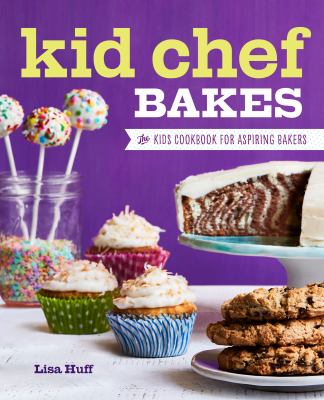Winter is a great time to bake bread. While it takes time to rise, the hands-on time of baking bread is minimal. Helping in the kitchen is useful for reinforcing following directions, practice with numbers, and is way to spend time with kids while bring productive.

This recipe is from Kid Chef Bakes, the kids cookbook for aspiring bakers, by Lisa Huff. It makes two loaves of white sandwich bread.
Tools:
- Stand mixer or large bowl
- Plastic wrap
- 2 loaf pans (8 ½ by 4 ½, by 2 ½)
- Pastry brush (optional)
- Wire rack
Ingredients:
- 2 cups warm milk (2% or whole is best, 105-115° f)
- 2 T sugar
- 1 (1/4-ounce) envelope active dry yeast
- 2 T butter at room temperature
- 1 T vegetable oil
- Butter for greasing pans
Prepare the Yeast:
In the bowl of a stand mixer with the hook attachment, or a large bowl using a spoon, mix the yeast, milk, and sugar. Let stand for 5 min.
Combine the Ingredients:
Add the 2 T butter, 4 c flour, and salt to the yeast mixture. Mix on low with the hook attachment until well blended. Add more flour as needed, a little at a time, until the dough forms. Raise the speed to medium and continue to knead for 4-6 minutes or until the dough is elastic. Alternatively, mix the flour in by hand and knead by hand for about 8 minutes or until the dough is smooth and elastic.
Let it Rise:
Grease a large bowl with oil. Add the dough and turn to coat, then cover with plastic wrap. Place in a warm place to double in size, about 1 hour (or more if your house is cool). Tip the dough out, split it, and form two loaves. Please each loaf in a greased loaf pan. Allow to rise again for about 30 min.
Preheat the oven to 350° F.
Bake:
Bake for 30-40 minutes or until brown and hollow sounding (bread should be about 200° F in the center when baked.) Cool slightly and then tip out onto a cooling rack. Cut when cool.
Making Butter:
If you are looking for something to do while your bread is rising, try making butter in a jar. All you need is heavy cream and a jar. Try this recipe: How to Make Homemade Butter
The Science of Yeast:
To learn more about yeast and for some simple yeast experiments, visit: https://redstaryeast.com/science-yeast/yeast-experiments/

